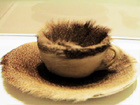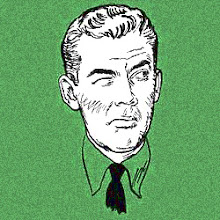Among the letters was this one from Ethel Tolbach of New York:
TO THE EDITOR: After adolescence, this is no time when modern poetry cannot be seen for the fraud it is. Recently a friend told me that William Carlos Williams was an exception. To my horror I found his poetry full of anti-democratic ideas, anti-Semitism, anti-Negro sentiments--the very symptoms of the virus of "modernism" which Mr. Shapiro discusses.*
 Actually this is about the one thing Shapiro did not discuss (nothing Shapiro said could have led directly to this woman's complaint). Poor WCW. In this period he was often attacked for being pink, radical, commie--too democratic, too inclusive (think Paterson)...and here, also, of the opposite.
Actually this is about the one thing Shapiro did not discuss (nothing Shapiro said could have led directly to this woman's complaint). Poor WCW. In this period he was often attacked for being pink, radical, commie--too democratic, too inclusive (think Paterson)...and here, also, of the opposite. I'm guessing that the charge of anti-Semitism is guilt by association with Pound, an infection spread by the "disease" (Shapiro's word) of modernism.
The odd double negative of the first sentence of this letter is of interest. It befits the antimodernist laments of the period 1945-60: concerns raised about modernism's pernicious influence are said to be urgent, but no alternative (except typically a return to what poetically there was before) is offered. So we don't say that 1960 is a time when we should do such-and-such new or different in poetry. We say it's not a time when we should not disclose failures and betrayals.
* NYT, Jan 10, 1960, p. 32.

 Is '60 the moment when the end of the end of the Old Left had been reached and the New Left began to emerge? Is it the final ascendancy, in certain scenes at least, of poetic postmodernity? Surely the publication of Donald Allen's The New American Poetry that year suggests this, but then again--once again--we look back on "New" here and see continuity. The rhetoric of the Kennedy-Nixon contest made much less of a dent than everyone (at the time as well as since) claimed, so one wonders why were such great claims made?
Is '60 the moment when the end of the end of the Old Left had been reached and the New Left began to emerge? Is it the final ascendancy, in certain scenes at least, of poetic postmodernity? Surely the publication of Donald Allen's The New American Poetry that year suggests this, but then again--once again--we look back on "New" here and see continuity. The rhetoric of the Kennedy-Nixon contest made much less of a dent than everyone (at the time as well as since) claimed, so one wonders why were such great claims made?  Had we come to expect "1960" to be truly ubiquitously modern in a way that the 1950s really were not--not quite? And what specifically does "modern" mean in the Kennedyesque talk then and now about the torch being passed to a new generation, etc.? The First Lady really meant "modernist" when Camelotians said "modern." What about the others across the new young cultural leadership? I've been surprised by how frequently the
Had we come to expect "1960" to be truly ubiquitously modern in a way that the 1950s really were not--not quite? And what specifically does "modern" mean in the Kennedyesque talk then and now about the torch being passed to a new generation, etc.? The First Lady really meant "modernist" when Camelotians said "modern." What about the others across the new young cultural leadership? I've been surprised by how frequently the  "Beat movement" was covered in 1960 in the mainstream press. I was expecting a fair measure but I've found tonnage. 1960 was the year when the figure of the beat was beginning to find acceptance, although still 80% of these stories are mocking, rebels-without-cause condescension. For anyone whose analysis made an impact nationally, do these antipolitical adolescents count as part of the "new young cultural leadership"? No, but rather than the two being opposites, they fall along a Continuum of the New American. Now that's a change for '60.
"Beat movement" was covered in 1960 in the mainstream press. I was expecting a fair measure but I've found tonnage. 1960 was the year when the figure of the beat was beginning to find acceptance, although still 80% of these stories are mocking, rebels-without-cause condescension. For anyone whose analysis made an impact nationally, do these antipolitical adolescents count as part of the "new young cultural leadership"? No, but rather than the two being opposites, they fall along a Continuum of the New American. Now that's a change for '60.







